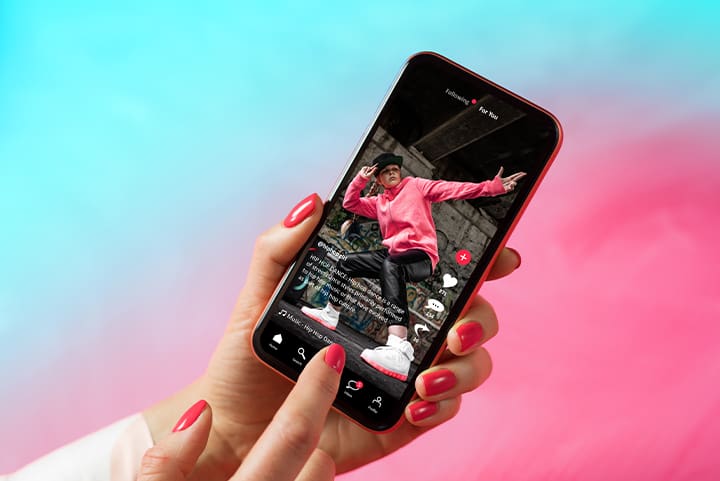The Wild Wild Web has a new sheriff in town: Gen Z. These Zoomers, as they’re known, are socially conscious, brand skeptical, and changing the digital landscape as we know it. If you’re disoriented, don’t worry. Implementing these Gen Z marketing trends authentically into your upcoming campaigns can help you win the loyalty of this audience. Let’s get to it.
If You’re Not Paying Attention to Gen Z Marketing, You Should Be
We blinked, and Gen Z was already heading to their pre-teens or mid-20s—in other words, some of the most influential ages for marketing. The idea of generational marketing—including Gen Z marketing—is understanding that age groups respond to messages (and channels) differently. They also have different social media habits, buying habits, and brand loyalty. If you take a one-campaign-fits-all approach, you will undeniably miss the mark in a few areas.
So, first things first: figure out your audience(s). If it happens to be primarily Gen Z, or a mix of Gen Z and Millennials, your approach will be vastly different than that targeting Gen X or Boomers. However, even if you’re not planning on marketing to Gen Z, the trends they’re informing have wide-ranging consequences across platforms and generations. So, as we said, if you’re not paying attention to Gen Z, now’s the time.
Defining the Generation
Before outlining the trends, let’s dive deep into this generation. Gen Z (born 1997 to 2012) accounts for more than 20 percent of the U.S. population, which amounts to 68.6 thousand Americans. They’re political justice and personal wellness advocates with top concerns including the cost of living, climate change, unemployment, mental health, and sexual harassment. They’re also a more inclusive generation, with over 80 percent supporting marriage equality.
Values-driven and socially adept, this generation spends almost three-quarters of their free time online, split between TikTok, YouTube, Facebook, WhatsApp, and Instagram. With their $143 billion in purchasing power, they primarily (83 percent) shop on social media and take digital first impressions very seriously (60 percent think they’re more important than in-person ones). That said, nearly a third of Gen Z unfollows or blocks brands weekly to weed out “companies they view as pretending to care, but really only caring about profit.”
We’ll leave you with one last stat here: 70 percent influence their family on purchasing decisions—which brings us back to the point that even if this gen is not your target, marketing to them is crucial.
Top Gen Z Marketing Trends
We’ll say it now: Understanding Gen Z marketing trends will make or break your entire digital marketing strategy. Bold, we know. But this generation is changing processes and interactions for everything from corporate America to brand responsibility. Following these trends (and staying on top of new ones) will help your brand stay relevant, authentic, and connect with this generation and beyond.
Be Personal and Direct
Raise your hand if you’ve ever received an email like this:
“Hi [NAME],
You’ve got an exclusive offer waiting for you at our shop. Click below to take advantage of it!”
Bonus points if the AI-generated [NAME] section didn’t autofill with your actual name. Yup, very personal. Gen Z has a distaste for inauthentic marketing that we’d bet spans generations. And, in the digital age, impersonal branding is something that your brand should constantly be pushing back against.
The best way to do this is by building a community around your brand—in-person or online. 41 percent of Gen Z feel more connected to brands when they post community-oriented content. They want to belong, feel included, and have the inside scoop that feels more like a friend talking with them than a brand talking at them. In this vein, Gen Z also values speaking directly (albeit virtually) with a brand’s customer service rep, not a bot.
By building a community that’s direct and personal, your brand can meet the needs of your audience on a different level than past generations. Gen Z is openly more anxious and lonely than generations past so having a brand community builds trust. You can do this by working with real people who embody your brand values, soliciting feedback from your audience, and celebrating loyal brand followers (free Crumbl cookies, anyone?).
Tempt The Eye
Over half of this generation uses social media to express themselves creatively, and they expect brands to do the same. TikTok, YouTube, and Instagram as the most-used social media channels for this gen showcase their love for visual media. They actively seek out (and engage with) short-form content that’s eye-catching, entertaining, bold, and—more often than not—humorous. TikToks and Reels using trending sounds, overlays, and visual effects can capture attention and help brands connect.
Gen Z marketing trends also show that interactivity is crucial. For brands, this means ditching the static, boring posts and creating ones that have users swipe, tap, and click. Part of making visually impactful content is understanding where this audience is. Because 95 percent of teens own smartphones and check social channels daily, frequent, entertaining posts can capture and keep their attention.
Capture Nostalgia
You know the joke that fashion never dies, just comes back in style? Well, Gen Z took that literally. The Zoomer generation is bringing everything-90s back, from fashion trends to nostalgic marketing. This is partly because 14 percent prefer to think about the past, 1.4 times more than Millennials. The reason? Uncertainty, anxiety, and loneliness from Covid-19 and the unstable economy.
Because of this, brands that tap into feelings of nostalgia and ‘simpler times’ connect with a generation that feels the weight of a struggling economy, climate, and collective mental health. Ironically, the nostalgia is for a pre-social media time, but it’s through these digital channels that Gen Z is making connections. To capture this vibe with your brand’s marketing, turn to feel-good memories, throwbacks, and 90s/early 2000s pop culture references. If you have an online-only shop, bring the nostalgia IRL with a clever throwback unboxing moment.
The ultimate goal is to foster a sense of belonging and provide “a calmness that can be hard to find in the chaotic present.”
Live Your Values
Mission-minded Gen Z marketing isn’t optional anymore; it’s mandatory. Over half of Gen Z wants brands to take a stance on topics like LGBTQ+ rights, diversity, and social responsibility. So it’s not enough anymore for your brand to tuck a mission statement away on the about page for the truly curious to find. Instead, your brand needs to authentically live its values through every touchpoint.
Brands often stay neutral or out of the conversation entirely regarding hot-topic debates for fear of alienating their customer-based. This is a failing strategy with Gen Z. Instead, they’re looking for brands to take a stance on “at least some topics.” To authentically do this, you need to assess your brand’s values and drive them home internally. For example, if you’re a proponent of diversity, hire a diverse team and influencers (who, by the way, half of Gen Z finds new brands through). If you want to fight climate change, invest in sustainable packaging, zero-waste processes, and recycled materials. Translation: be the change.
Work With a “Genuinfluencer”
GWI’s recent report on Gen Z marketing trends highlighted some pretty interesting concepts, including the idea of a “genuinfluencer.” In contrast to influencers who brands tap to sell products, this new breed of social influencing aims to share information and advice in relatable, genuine ways. When Simone Biles authentically shared her mental health struggles during the 2021 Summer Olympics, her candor gained 1.8 new followers on Instagram.
Likewise, when the pandemic changed the tone of online content, genuinfluencers gained traction and started working with brands to curate ideas, join conversations, and dig deeper into brand values. The idea of connecting with an audience on a more real, less market-y level resonates with Gen Z.
Make Branding Entertaining
Part of marketing to a generation with increased mobile use and decreased attention spans is making every piece of content you put out entertaining. Most of this generation prefers videos to be under a minute and can filter a high volume of content in a short period. With all the social noise, brands need to emotionally connect and entertain to stand out.
The tricky part is that 69 percent of Gen Z think ads are disruptive. So rather than writing and designing creative ad content, brands need to focus on creating personal, funny, direct, and authentic content. When you focus on short, memorable content (through Reels or TikTok, for example) that’s educational, entertaining, or valuable, your marketing does more than add to the noise.
Train (Don’t Just Trust) The Algorithm
Lastly, SEO isn’t a secret anymore. Gen Z knows how to “train” the algorithms to see their desired content. Marketers should do the same. What do we mean by train? Gen Z will interact with content in some way (likes, reshares, comments) to see more of the same type of content—whether for a fashion brand or Fido the dog.
By paying attention to your audience’s needs (and following social insights), you can ensure your content falls into the categories that will make the biggest splash for your audience. On that SEO note, Gen Z’s search habits are also changing marketing, with nearly half now using TikTok to search instead of Google. Really puts the ‘key’ in keyword strategy.
We’ll say it one more time (for the people in the back): these marketing trends may have started with Gen Z habits and values, but they are becoming trans-generational and important for marketing strategies across industries.
Campaign Examples Implementing These Trends
With all this talk of visually-forward, entertaining content for Gen Z, we can’t not highlight brands making Gen Z marketing look easy.
Juicy Couture
Hype culture is best described as always looking for the next big thing. Brands like Juicy Couture have taken hype culture to the next level by adding “a dash of nostalgia” that strengthens the sense of brands ‘getting it.’ Its Ganni x Juicy Couture line took the throwback Y2K style with limited edition tracksuits and almost instantly sold out. The campaign was a perfect example of a brand “tapping into comforting images still lodged in their [audiences] consciousness.”
Crumbl Cookies
The only kind of internet cookies Gen Z likes? Crumbl. The cookie company’s digital-first marketing strategy has ‘taken over’ TikTok with most of the Gen Z trends we outlined above. With their incredible visual storytelling, they’re literally tempting the eye (and stomach) while using short-form videos with trending sounds. In addition to engaging the senses, their customer service is personal and direct with social managers heavily interacting throughout their channels with giveaways, support, and hype of their own. By nurturing this brand loyalty and making content highly entertaining, they have social followings closer to Nike than their cookie peers.
Duolingo
Language learning app, Duolingo, has the art of translating Gen Z values down. Much like genuinfluencers take a lifestyle vs. product approach, the brand’s mascot (Duo the owl) focuses less on the brand and more on the quirky, humorous ways it can interact with its users. The Gen-Z-run social account has personified the brand via the green owl “with a penchant for chaos.” And these interactions allow users to get to know the brand—and its values (like LGBTQ+ rights)—on a personal level.
Get Savy With Gen Z Marketing Trends
Not us sprinting to our campaigns to freshen them up with Gen Z marketing trends… But, really, if it’s been a few months (or years, we’re not judging) since you assessed your digital marketing strategy and followed the trends, now’s the time. And when you’re feeling stuck, the Savy team’s marketing experience is at your fingertips.

